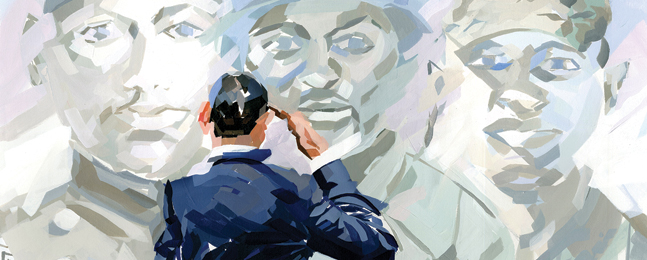Perspective
A Battle Cry for Equality
Commander in Chief Barack Obama symbolizes the achievements of African-Americans who have fought for their country and against racism in the armed forces for more than two centuries.

Matthias Christensen
by Chad Williams
Arguably, the signature event of Barack Obama’s first term occurred on the night of May 1, 2011, in the East Room of the White House, when the president announced Osama bin Laden’s death. The world would soon learn details of the high-risk covert operation on Pakistani soil that the president had approved in the face of great uncertainty. The killing of bin Laden dramatically recast the image of Obama as commander in chief and presented a striking picture of military leadership.
The historic nature of Obama’s presidency has received much attention. But what does it mean to elect not just the first African-American president but the first black commander in chief? Obama’s embrace of this title and the American public’s widespread acceptance of him in the role reflect a significant evolution of both the image and the power of African-Americans as leaders of the nation’s armed forces.
For much of U.S. history, the very idea of African-Americans holding leadership roles in the military generated considerable controversy and outright opposition. Beginning with the Revolutionary War and continuing well into the 20th century, the thought of black men occupying positions of authority over white men ran against societal conventions as well as ingrained military customs.
The story of African-American officers, in particular, has been one of tragedy, perseverance and triumph. The military viewed awarding black men officer status as not only a radical inversion of racial hierarchy but also a way to give them a potentially dangerous sense of manhood and citizenship. Between 1877-1936, only four African-Americans graduated from West Point.
World War I was a crucial episode in the history of military leadership. African-Americans were determined to transform a war to make the world “safe for democracy” into an opportunity for greater social and political rights. After facing pressure from the black press and civil rights activists, the U.S. War Department agreed to the creation of a training camp for African-American officers in Des Moines, Iowa. The camp brought together some of the most accomplished blacks of the day — lawyers, doctors, businessmen, star athletes — who equated military leadership with racial advancement. By the end of the war, more than 1,200 African-Americans had received officer commissions.
Despite this achievement, white hostility to the presence of African-American officers remained intense. The highest-ranking black officer when America entered the war, Colonel Charles Young, was unceremoniously forced to retire for health reasons. Other officers endured virulent racial discrimination and emotional abuse from their fellow Americans. In France, black officers were slandered as ineffective leaders and became scapegoats for the alleged poor performance of one of the African-American combat divisions.
After World War I, military leaders vociferously debated the future of African-Americans in the armed forces. They determined that the “experiment” of African-American officers had been a failure and that in future wars they should serve only in a limited capacity. This policy shaped the opportunities made available to African-American officers throughout the interwar period and into World War II.
page 2 of 2
The integration of the armed forces after World War II began to transform the place of African-Americans in the military and undermine the idea that they could not be effective leaders. In 1948, President Harry Truman issued an executive order prohibiting racial segregation throughout the military, although enforcement remained a problem. Both the Korean and Vietnam wars witnessed a dramatic transformation in the armed forces’ racial composition and the number of African-Americans in positions of command.
Amid this changing climate, Colin Powell took advantage of the military’s commitment to improving racial diversity and advancing the careers of black officers. Powell, who received his first officer commission in 1958, steadily ascended through the ranks, holding prominent positions in the Pentagon and the White House. In 1989, President George H.W. Bush appointed Powell chairman of the Joint Chiefs of Staff, the first African-American to hold the job.
During the Persian Gulf War, Powell emerged as a nationally respected and authoritative figure. Upon Powell’s retirement from active duty in 1993, many pundits considered him to be a viable presidential candidate who could garner widespread white support across the political spectrum.
This made Obama’s courting of Powell’s support during the 2008 campaign, and Powell’s eventual endorsement, especially significant. Powell gave Obama crucial legitimacy, not only as a potential commander in chief but as an African-American who, like Powell, possessed the qualifications, temperament and leadership abilities to assume control of the nation’s armed forces. Powell again supported Obama in 2012 and lauded his foreign policy record.
As commander in chief, Obama has by no means fully shed historical concerns about African-Americans as military leaders. Challenges to the president’s citizenship, and therefore his very right to be commander in chief, contain a clear racial dimension. Nevertheless, the once unimaginable thought of a black person being responsible for the safety of the American people and holding final authority over the use of military power has become a widely accepted reality.
In his second term, the president faces a host of difficult foreign policy and military-related questions. What he won’t confront is much doubt about his ability to lead our armed forces.
Chad Williams is an associate professor of African and Afro-American studies.
